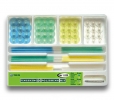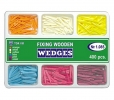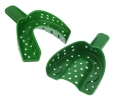|
the treatment of anterior edentulousness is both a functional and aesthetic challenge, all the more so as the space for replacement is small. to compensate for this diffi culty, systems have been supplemented with small-diameter implants that differ in terms of size and shape, especially the implant connection. this article analyses the interest of small-diameter implants through a brief review of the literature, then presents the latest advances in implant systems, developed to meet the two constraints of cases of anterior edentulousness: the replacement of mandibular and upper lateral incisors and aesthetics. Introduction the management of small-diameter anterior edentulousness is a challenge in many respects for implantologists. Because of the anterior location, it is essential that perfect aesthetic results be achieved. the limited space between adjacent teeth combined with low bone volume present real surgical diffi culties in ideal implant placement. indeed, a standard-diameter implant presents indisputable dangers for collateral teeth as well as for the fi nal aesthetic results. Previously, these clinical situations were treated with bonded bridges or orthodontically by replacing the missing teeth using collateral ones. When it is possible to place a standard-diameter implant, it is the prosthetist’s responsibility to align the implant and the fi xture on one hand, and, on the other hand, the prosthesis. yet their respective dimensions are different, which is why unsatisfactory aesthetic results are often obtained. manufacturers offer small-diameter implants that are different in terms of their shape, more or less reduced diameter, and especially by their implant connection. this latter is one of the keys to success in the reliability of implant osseointegration. in accordance with this choice, we will be able to obtain results that meet current aesthetic requirements. it will also allow for a more or less wide range of choices for reconstruction of the missing tooth. this article fi rst offers an analysis of the literature on osseointegration and prosthetic connections of small-diameter implants. it then presents the B mm diameter implant through a few clinical cases. Reliability of narrow implants Dental implants are a reliable therapy for the treatment of totally[1, 2] or partially[3, 4] edentulous patients. Generally, the use of standard-diameter or large-diameter implants is recommended in order to ensure adequate boneimplant contact[5]. it is recommended that 2-3 mm of space be left between the implant surface and the natural collateral root surface[6]. However, the smaller mesiodistal diameter of certain anterior teeth or the thinness of the bony ridge does not always allow for such implants to be placed. We know that in the case of single-unit restoration, the survival rate of standarddiameter implants is 94.4[7] to 96%[8]. What about narrow implants? the authors wanted to know the relationship that exists between the diameter, length of the implant and resistance to loosening of osseointegrated implants. the fi rst study[9] seemed to prove that resistance to disinsertion was more related to the length of the implant than the diameter. another study[10] compared the same resistance to loosening by analysing 3.25 mm and 4.25 mm diameter implants. the slight difference (15%) between the two seems fairly insignifi cant for the authors. accordingly, Davarpanah et al.[11] concluded that small-diameter implants are indicated when the interradicular space is small and when the bony ridge is thin or for teeth with small cervical diameters. Polizzi et al.[12] clinical results at seven years on the use of narrow single-unit implants for the replacement of maxillary and mandibular incisors give a success rate of 96.7%. Vigolo et al.[13] obtained a survival rate for small-diameter implants of 95.3%. it should be noted that this study includes narrow implants placed elsewhere than in anterior zones and that these implants have also been used to replace multiple missing teeth. Under these conditions, narrow implants were associated with standard-diameter implants. the authors drew the same conclusion: no signifi cant difference can be shown between the survival rate of narrow implants and that of standard-diameter implants. thus, the use of small diameter implants is currently considered to be a reliable therapy. Reliability and interest of morse taper connection an exhaustive analysis of existing narrow implants has made it possible to establish the following assessment. Monoblock implants through their body and neck diameters less than or equal to 3 mm, these implants are a good opportunity when a standard-diameter implant cannot be used. However, in most cases, this type of implant has the major disadvantage of offering only a single abutment axis. indeed, this is incorporated in the implant. it is therefore in its large axis. clinical situations in which the implant and prosthetic axis diverge become more complicated to manage. Traditional two-piece implants Some have an implant body from 3 to 3.25 mm, but with a neck diameter of 3.4 mm. this option allows for the management of thin crests and makes it possible to use more fi xture axis. However, the 3.4 neck diameter seems less favourable in situations in which the distance between teeth is very small. there is an implant system with a 3 mm diameter implant body and neck. the fi xture is fl ared above the implant-abutment connection of 3.4 mm. these two-piece systems have the same characteristic: the abutment is screwretained. the very existence of the screw limits getting diameters less than 3.4 mm at the implant/prosthetic component junction. an even greater decrease in the material thickness in this type of screw-retained construction results in a fragility that is harmful to long-term reliability. the B mm diameter implant is used exclusively for the replacement of mandibular incisors or maxillary lateral incisors. this implant has a real neck diameter of 2.8 mm with a morse taper connection with integrated “platform switching”. the abutment is impacted without transfi xation screw and without indexing and has three gingival heights (2.5-4 and 5.5 mm) and four angulations (0°, 7°, 15° and 23°). two conditions appear to be present simultaneously : > a true narrow diameter over the entire length of the implant as well as in terms of the prosthetic components; > a signifi cant choice in the prosthetic axes. two questions are now asked: 1. Do the implant and the prosthetic parts present resistance to breaking and elastic resistance compatible with use in the zones for which it is intended? the answer is clinically yes. endurance tests are also favourable: comparative physical tests have been carried out in accordance with the iSO 14801 standard (anthogyr) (Fig. 1). 2.in cases of anterior single-tooth edentulousness, is the use of impacted abutments without indexing a reliable solution in terms of osseointegration? Does this type of construction have an impact on the loss of abutments? Bone loss at the neck of the implant with screw-retained abutments is generally 1.5 to 2 mm below the implant/abutment junction after one year of use[14]. However, there is less bone loss when the screw-retained system is associated with a morse taper connection. according to several authors[15-24], this might be related to a signifi cant decrease in micro-movements between the two parts. the presence of “platform switching” would cause a mucous ring related to epithelial organization protecting the crestal bone[25-30]. the signifi cant mechanical stability of the morse taper connections allows for sealed prostheses. concerning the stability of impacted abutments, these same authors[15-24] observe a decrease in the loss of abutments with these connections. the same is true of the replacement of single teeth: the use of morse taper results in a decrease in the loss of abutments[15-19]. mangano et al.[31], after a four-year clinical study and 307 single-unit implants placed, including 115 in maxillary and mandibular zones, conclude that the use of the morse taper connection without transfi xation screw is a good solution for replacing a single missing tooth. Fig. 1 - result of the endurance test (Source: anthogyr)
The axiom 2.8 mm diameter implant The axiom 2.8 mm diameter implant has been designed exclusively for the replacement of mandibular incisors and/or maxillary lateral incisors. It has a BCP® (Biphasic Calcium Phosphate) surface treatment and has a Morse taper connection with integrated “platform switching”. The abutment is impacted. It is available in three gingival heights (2,5 - 4 and 5,5 mm) and four abutment angulations (0°, 7°, 15° and 23°), and 3 lengths (10, 12 and 14 mm) (Fig. 2).
Clinical case presentation Two clinical cases are presented in which t the axiom 2.8 mm diameter implant was used (case n° 1: Fig. 3 to 13 and case n° 2: Fig 14 to 17). Case 1 : Maxillary lateral incisor agenesia The patient is a woman, aged 30. She suffers from agenesia of maxillary lateral incisors.
The temporization phase with these temporary teeth is of capital importance for fast and good gingival outline (teeth alignment, development of papillae). It resulted in an easy and fast development of papillae. Indeed, the small diameter of the implant allows for the preservation of “thick” bone ridges. Bone ridges will allow for supporting gingival, and thus, papillae. Depending on the development of papillae, the temporary crowns will be replaced by the definitive ones. 4 weeks after, the definitive crowns are performed.
Case 2 : Mandibular incisor agenesia The patient is a young man, aged 18. He suffers from a double agenesia of mandibular incisors.
Discussion the safety of the use of this new narrow implant for replacement of maxillary lateral incisors and mandibular incisors is demonstrated doubly : from a clinical standpoint and through mechanical tests. indeed, because of its small diameter,The axiom 2.8 mm diameter implant body is further from collateral teeth. as a result, there is greater residual bone thickness between the different roots, whether natural or artifi cial. this bone thickness results in increased bone stability at the neck of the implant. associating a taper-type connection and “platform switching” could only improve this bone stability. this criterion is all the more crucial as this implant is indicated for cases in which bone volume is naturally reduced (agenesis, thin crests, limited interdental spaces). the prosthetic abutment has a 2.8 mm diameter with different heights and angulations. this gives the practitioner a wide range of choices in terms of creating the future prostheses. However, there is a question that merits consideration : when four mandibular incisors are missing, is it possible to consider placing only two implants in place of 32-42, then creating a four-tooth bridge supported by two narrow implants? Conclusion replacing small-diameter teeth with The axiom 2.8 mm diameter implant is an interesting option for ensuring optimal aesthetic results while preserving the patient’s bone. Bibliography adell r, lekholm U, rockler B, Brånemark Pi. a 15-year study of osseointegrated implants in the treatment of the edentulous jaw. int J Oral Surg. 1981 Dec; 10(6):387-416. lindquist lW, carlsson Ge, Jemt t. a retrospective 15 year follow-up study of mandibular fi xed prosthesis supported by osseointegrated implants: clinical results and marginal bone loss. clin Oral implants res. 1996; 7: 329-336 Jemt t, lekholm U, adell r. Osseointegrated implants in the treatment of partially edentulous patients: a preliminary study on 876 consecutively placed fi xtures. int J Oral maxillofac implants. 1989 Fall;4(3):211-7. Jemt t, Pettersson P. a 3-year follow-up study on single implant treatment. J Dent. 1993 aug;21(4):203-8. lazzara rJ. criteria for implant selection: surgical and prosthetic considerations. Pract Periodontics aesthet Dent. 1994 nov-Dec;6(9):55-62; quiz 64. Hobo S, icida e, Garcia lt. Osseintegration and occlusal rehabilitation. chicago iii: Quintessence Publ co inc; 1989. cordioli G, castagna S, consolati e. Single-tooth implant rehabilitation: a retrospective study of 67 implants. int J Prosthodont. 1994 nov-Dec;7(6):525-31. engquist B, nilson H, astrand P. Single-tooth replacement by osseointegrated Brånemark implants. a retrospective study of 82 implants. clin Oral implants res. 1995 Dec;6(4):238-45. Block mS, Delgado a, Fontenot mG. the effect of diameter and lenght of hydroxyapatite-coated dental implants on ultimate pullout force in dog alveolar bone. J Oral maxillofac Surg 1990; 48:174-178. Kido H, Schulz ee, Kumar a, lozada J, Saha S. implant diameter and bone density: effect on initial stability and pull-out resistance. J Oral implantol. 1997; 23(4):163-9. Davarpanah m, martinez H, tecucianu JF, celletti r, lazzara r. Small-diameter implants: indications and contraindications. J esthet Dent. 2000;12(4):186-94. Polizzi G, Fabbro S, Furri m, Herrmann i, Squarzoni S. clinical application of narrow Brånemark System implants for single-tooth restorations. int J Oral maxillofac implants. 1999 Jul-aug; 14(4):496-503. Vigolo P, Givani a, majzoub Z, cordioli G. clinical evaluation of small-diameter implants in single-tooth and multiple-implant restorations: a 7-year retrospectivestudy. int J Oral maxillofac implants. 2004 Sep-Oct;19(5):703-9. Hermann JS, Schoolfi eld JD, nummikoski PV, Buser D, Schenk rK, cochran Dl. crestal bone changes around titanium implants: a methodologic study comparing linear radiographic with histometric measurements. int J Oral maxillofac implants. 2001 Jul-aug; 16(4):475-85. Hansson S. a conical implant-abutment interface at the level of the marginal bone improves the distribution of stresses in the supporting bone. an axisymmetric fi nite element analysis. clin Oral implants res. 2003 Jun; 14(3):286-93. Sutter F, Weber HP, Sorenson J, Belser U. the new restorative concept of the iti dental implant system: Design and engineering. ins J Periodontics restorative Dent 1993; 13:409-431. Weigl P. new prosthetic restorative features of ankylos implant system. J Oral implantol. 2004; 30(3):178-88. Döring K, eisenmann e, Stiller m. Functional and esthetic considerations for single-tooth ankylos implant-crowns: 8 years of clinical performance. J Oral implantol. 2004; 30(3):198-209. norton mr. assessment of cold welding properties of the internal conical interface of two commercially available implant systems. J Prosthet Dent. 1999 Feb; 81(2):159-66. 20. chee W, Felton Da, Johnson PF, Sullivan Dy. cemented versus screwretained implant prostheses: which is better? int J Oral maxillofac implants. 1999 Jan-Feb; 14(1):137-41. 21. muftu a, chapman rJ. replacing posterior teeth with freestanding implants: fouryear prosthodontic results of a prospective study. J am Dent assoc. 1998 aug; 129(8):1097-102. morgan Km, chapman rJ. retrospective analysis of an implant system. compend contin educ Dent. 1999 Jul; 20(7):609-14, 616-23 passim; quiz 626. romanos Ge, nentwig GH. Single molar replacement with a progressive thread design implant system: a retrospective clinical report. int J Oral maxillofac implants. 2000 nov-Dec;15(6):831-6. mangano c, mangano F, Piattelli a, iezzi G, mangano a, la colla l. Prospective clinical evaluation of 307 single-tooth morse taper-connection implants: a multicenter study. int J Oral maxillofac implants. 2010 mar-apr; 25(2):394-400. Gadhia mH, Holt rl. a new implant design for optimal esthetics and retention of interproximal papillae. implant Dent. 2003; 12(2):164-9. lazzara rJ, Porter SS. Platform switching: a new concept in implant dentistry for controlling postrestorative crestal bone levels. int J Periodontics restorative Dent. 2006 Feb; 26(1):9-17. Baumgarten H, cocchetto r, testori t, meltzer a, Porter S. a new implant design for crestal bone preservation: initial observations and case report. Pract Proced aesthet Dent. 2005 nov-Dec; 17(10):735-40. Guirado Jl, yuguero mr, Zamora GP, munoz Be. immediate provisionalization on a new implant design for aesthetic restoration and preserving crestal bone. implant Dent 2007; 16:155-164 rompen e, Domken O, Degidi m, Pontes ae, Piattelli a. the effect of material characteristics, of surface topography and of implant components and connections on soft tissue integration: a literature review. clin Oral implants res. 2006 Oct; 17 Suppl 2:55-67. Degidi m, iezzi G, Scarano a, Piattelli a. immediately loaded titanium implant with a tissue-stabilizing/maintaining design (‘beyond platform switch’) retrieved from man after 4 weeks: a histological and histomorphometrical evaluation. a case report. clin Oral implants res. 2008 mar;19(3):276-82. mangano c, mangano F, Piattelli a, iezzi G, mangano a, la colla l. Prospective clinical evaluation of 307 single-tooth morse taper-connection implants: a multicenter study. int J Oral maxillofac implants. 2010 mar-apr;25(2):394-400. Source: implant journal France |
Send Money, Transfer Money or Pay Online with PayPal
The replacement of small-diameter teeth in aesthetic zones
Related products
Jota - Diamond Burs - Round - FG

Tor VM - Finishing & Polishing Kit (Stem Disc+Strip)

Tor VM - Wooden Wedges of 6 Types

Taksan - Dr.Roufi Tray








